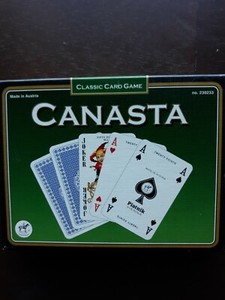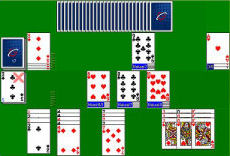

A book with no wild cards is considered clean or red, and will score a higher bonus than a dirty or black book, which has at least one wild card. Melds with less than 7 cards are considered open. Melds of seven cards (or more) are considered to be complete, and may be referred to as books bonuses are awarded for these melds. The objective of the game is to create melds consisting of 3-7 (or sometimes more, depending on house rules) cards of the same rank, possibly including wild cards. A game is ended either after a fixed number of rounds, or by a team reaching a specified score. 'Clean' melds, which have no wild cards, are awarded more points than 'dirty' melds, which have one or more. Points are awarded for each card played, and bonuses are awarded for completed (seven-card) melds. Red 3s are generally treated specially: they are played automatically on the board, and the player draws a replacement card. Black 3s are generally not permitted to be melded, and must be discarded. The number of wild cards in a meld are usually limited to two or three, although melds of exclusively wild cards are permitted in many game rules. Melds must be at least three cards in size, and are usually restricted to have no more than seven. The objective of the game is to create melds of cards of the same rank, possibly with the inclusion of wild cards, which are either jokers or deuces. The game supports a number of variant playing rules, based on a diversity of published rule sets. It supports from 3 to 7 players playing as individuals, with team play possible for as many as 12. The interface aligns automatically and displays the cards in optimal size.This is an implementation of the Canasta variant called Hand and Foot, in which players receive two sets of cards, played according to variations of standard Canasta rules, in which cards are played into melded sets. Adjust the game to a one-handed or two-handed playstyle when on the go. Another popular feature is the support of landscape and portrait mode for mobile devices in all our games. They are particularly suited for playing on devices with smaller screens.

Hence, we designed additional decks with optimized legibility. Traditional card decks may vary in clarity depending on your display size.

And once you got the hang of the Canasta game, you can compete live: Rise up in the league system, play in tournaments and join clubs! Once you start playing, you are always collecting experience to level up. At the push of the Quick Match button, you will automatically enter a table with fellow players that match your skill. When using mobile devices, there is no need to set up an account – just start playing. So, we came up with a couple of ideas to make playing Canasta free, easy, and accessible right off the bat. Some card games scare people off with complicated rulebooks. Sales numbers of playing cards and literature on the game increased accordingly. It ranked among the most played card games as soon as the 1950s. Once published, Canasta traveled quickly over the whole world.

Their passion for another card game, Bridge, spurred them to compile their own game. Written historic accounts agree on Segundo Santos and Alberto Serrato developing Canasta in 1939 in Uruguay. The main element of the game is collecting seven cards of the same rank, then using them to form a figure of the same name. The name Canasta is derived from a Spanish word for a basket that would originally hold the playing cards. You will also have to plan ahead and play cooperatively.Ĭanasta is related to Rummy – just a bit more interesting and trickier. To win in this game you need to combine skills such as memory, focus, and attention. At the Palace, Canasta is available for two or four players. It is usually a four-player game with two teams, though there are variations for different numbers of players. Canasta is one of the youngest classic card games.


 0 kommentar(er)
0 kommentar(er)
